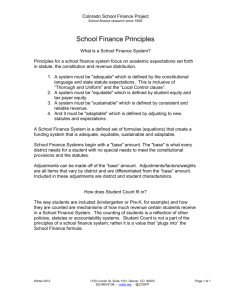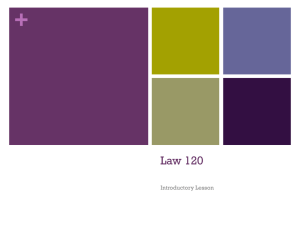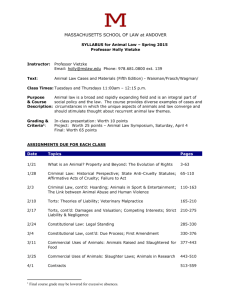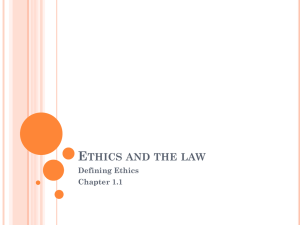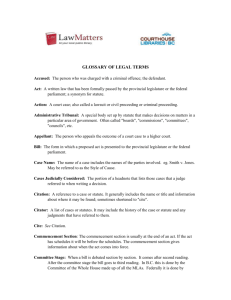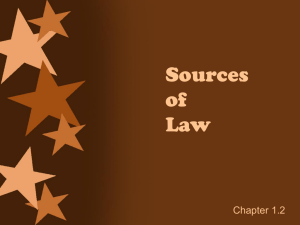The Origins of Statutes - David Elliott's Website
advertisement
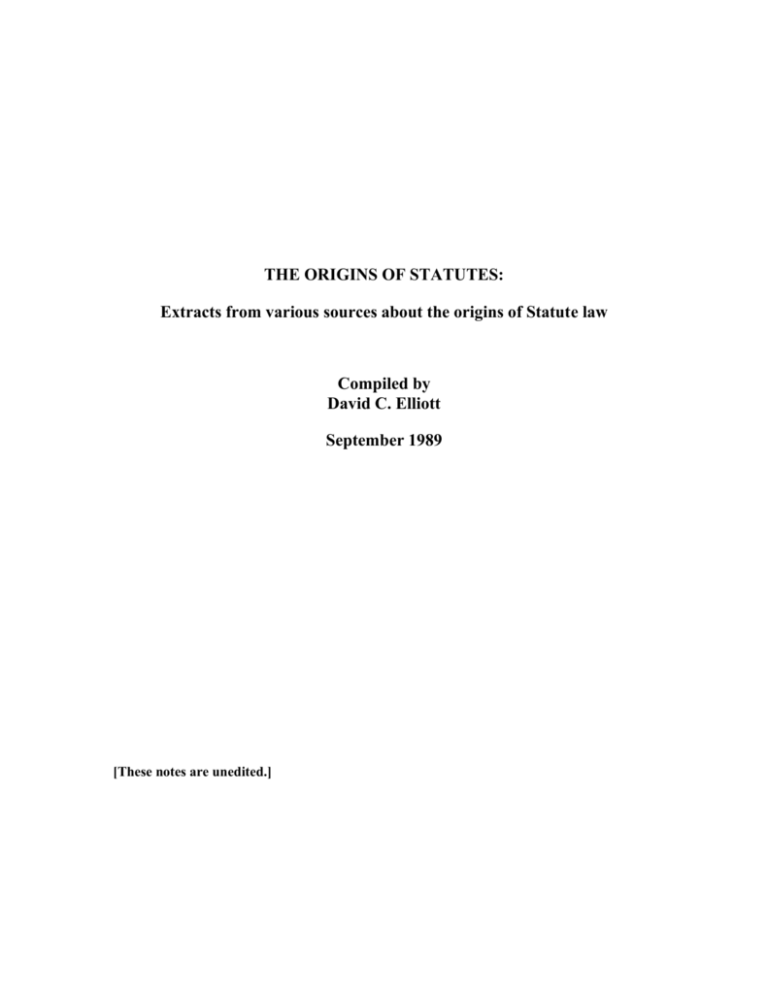
THE ORIGINS OF STATUTES: Extracts from various sources about the origins of Statute law Compiled by David C. Elliott September 1989 [These notes are unedited.] Contents Chapter 1 The phases of drafting Acts of Parliament ..................................................................... 1 Background First phase Second phase Third phase Chapter 2 In early times: what was a statute? ................................................................................. 3 Plucknett's answer Chapter 3 Other views of the early statutes...................................................................................... 4 Preparation of Acts Beginnings of legislation Early Devolution of Powers Chapter 4 The language of statutes ................................................................................................. 10 Latin Recording statutes Legislating for the English language Appendix .......................................................................................................................... 11 The English for lawyers law 1733 Endnotes........................................................................................................................... 12 Chapter 1 The phases of drafting Acts of Parliament Background In the General Preface to Mr Plucknett's study of Statutes and their Interpretation in the Fourteenth Century, Professor Harold Hazeltine provides this background to enacted law: The problems of the enacted law and its interpretation are vastly more complex in medieval times than they are in our modern age; and, as a consequence of this complexity, the medieval problems are vastly more interesting. Their solution will carry the student from medieval into modern times; and it will help him to reach sound solutions if he can survey the whole course of English legislation from the days of Aethelbehrt to our own time. One of the most valuable lessons which this survey will teach him is that royal legislation in the middle age assumes many different forms. The king legislates by doom and charter, by writ and provision, by ordinance and statute, and by other forms. This variety in the forms of the king's medieval legislation produces its own special problems in the matter of interpretation; and these problems are further complicated by the fact that the early common law judges who interpret the legislation have sometimes had a prominent part in drafting it and in giving it validity. The rise of the parliament - the king in parliament - as the sovereign legislative power in the state tends to a simplification of the processes of legislation by making the statute law supreme over all other forms of legislation: and the simplification of legislation simplifies at the same time the processes and principles of judicial interpretation. In a helpful overview(1) Sir Noel Hutton, former First Parliamentary Counsel, suggested that the United Kingdom was in the third phase of drafting Acts of Parliament. Sir Noel described the phases as follows. First phase: In the first phase, legislation was initiated by a petition exhibited in Parliament by one of the Houses – usually the House of Commons – to which the appropriate Royal Response was given. When a change in the law was made as the result of a favourable Response, the new law was subsequently drafted by a committee of judges and officials, and promulgated by copies being sent round the Kingdom under the Great Seal and by being entered upon the Statute Roll. Internal evidence of subsequent drafting in this period is to be found in the following from 1 Edward IV cap. II: "And that this ordinance be in his (sic) force, and begin to take effect at the fortieth day next after the sixth day of May, next after the beginning of this present Parliament, upon the which sixth day the said Parliament was dissolved". This procedure led to complaints that the intentions of the Houses were not being properly interpreted by those who drafted the Statutes; and Second phase: In the fifteenth century the second phase began, in which the petition incorporated a draft of the law which was requested. Such a petition was called in the Rolls of Parliament "Billa continens in se formam Actus", and this is the precursor of the modern Parliamentary Bill. During this phase the drafting was carried on by private enterprise, the degree of privacy in the enterprise depending (naturally) on the promoters of the relevant Bills (see, for a description which may perhaps owe something to imagination, Jacob's Law Dictionary, 4th Edition, title Parliament). Tradition has it that Henry VIII did a good deal of his own drafting in person, and if that is the case it must have been more perilous than it is today to engage in the national sport of jeering at the results. In any event the language of the Acts of that period (whether Royal or not) is of such supreme quality as to fill any modern draftsman with despair. A more modern (and less admired) enactment which is reputed to have been influenced by the Royal hand was repealed by s. l of the Criminal Procedure (Insanity) Act 1964. Third phase: The third phase can be traced back to the beginning of the nineteenth century, when the Government began to nationalise legislation. During the first half of that century various individual draftsmen had been employed as Parliamentary Counsel in the Treasury, and later in the Home Office; but the present system, under which the Government's public Bills are prepared by a body of professional draftsmen available indifferently to all departments, really dates from 1869 when Henry Thring (who had been Parliamentary Counsel to the Home Office since 1860) was appointed by Treasury Minute as Parliamentary Counsel and funds for the employment ad hoc of other members of the Bar. Thring was a draftsman of phenomenal capacity, as well as the author of the handbook entitled Practical Legislation which (leaving aside Bentham's Nomography and Coode's Legislative Expression) was the first of the standard textbooks on the subject of legislative drafting but (in common with most such works by English lawyers) is long since out of print. It is not proposed to enumerate his successors, but some of their names are more or less familiar as the result of publications other than their Bills, for example(2) Courtenay Ilbert, Legislative Methods and Forms and The Mechanics of Law Making; McKenzie Chalmers, Bills of Exchange, Sale of Goods and The Marine Insurance Act; William Graham Harrison, Main Criticisms of the Statute Book and the Possibility of Improvement (Journal of the Society of Public Teachers of Law, 1935); and Granville Ram, Improvement of the Statute Book (Ibid., 1951) One of the best things written on the drafting process is an article contributed (anonymously) by Alan Ellis to the Symposium 2 entitled Parliamentary Government in Britain, published by the Hansard Society in 1949.(3) Chapter 2 In early times: what was a statute? Plucknett's answer The answer is not easy, for neither the form nor the procedure of enactment will help us; the form is varied, and the procedure is often undisclosed. Tests of that sort fail us for the very significant reason that they were not contemporary tests. Hence there has been some confusion (especially in the older law-books) between what a modern lawyer would regard as having been a statute, and what the contemporaries of Edward I described by the word. The only safe course is to say, quite simply, that those things are statutes which contemporaries themselves describe by that word. In other words, the description of "statute" is acquired by repute. We must regard as contemporaries, moreover, those who were best qualified to know – above all, the courts, for it was their duty to know. It is not necessary to believe that every scrap in private compilations which is there called a "statute" is truly one. That indeed would lead us into error; but when the superior courts describe a very recent document as a statute, then surely we are bound to accept their evidence. That evidence is becoming available in some volumes now that the plea rolls of Edward I and Edward II are being used and, in part, printed by historians. It is much more difficult to guess by what means a medieval court made up its mind. It seems unlikely that there was any diplomatic, or technical, or constitutional criterion; once again repute and practice would normally settle the matter quite early, for most statutes deal with matters of some urgency and so are likely to come before the courts fairly soon. One thing seems tolerably plain as distinguishing a statute from those other documents and modes of legal change which have just been mentioned. That is, that a statute is a text which is current among the legal profession and, indeed, among the public generally.(4) The fact that a statute was a written text and widely published produced in the fullness of time a revolution in our legal system, for it gave us a new and a very different source of law. Nevertheless, the process was slow and much of it lies in later reigns. The essential point for the purpose of this study is that during the reign of Edward I that revolution had only just begun, and that those documents which had already acquired the repute of being "statutes" had not yet acquired the precise juridical characteristics which were later inseparable from the conception of a statute in English law. For a generation or two they were still regarded in much the same way as those other documents and modes of legal change which we have been considering; in essence they were merely modifications of 3 the elastic web of the customary common law. The fact that they were in a written, published form was still only an accident. As yet, the interpretation of such documents is merely the process of their reception into the larger fabric, with such modifications of both as might be necessary to achieve a practically satisfactory result. The whole process was conceived, as it were, as taking place inside the closed system of the common law.(5) Plucknett has an interesting comment on the 1800 edition of the Statutes of the Realm. He says on page 19: The vast Statutes of the Realm edition incontestably makes good its claim to be the completest collection in existence; in other words, it contains the largest and most varied collection of apocrypha. Its editors were technically competent, but extraordinarily timid. They assembled the materials for a thoroughly critical text, but were so dominated by the tradition of the legal profession that they often printed a corrupt text, because it was the familiar one, and relegated the better readings to the footnotes. Furthermore, our earliest statutes are in French (or occasionally Latin), and so a translation was desirable. This need had been felt since the early sixteenth century, and the early printers had been at pains to provide one. This traditional version was a poor performance based upon unsatisfactory texts of the French and Latin. Nevertheless, it was these traditional versions which the editors of the Statutes of the Realm decided to print beside their variorum text. Once again, they knew the shortcomings of the versions they printed, and put some (but not enough) corrections in their footnotes.(6) The reader who makes diligent use of the footnotes will generally arrive at a sound text and translation.(7) Where the Statutes of the Realm is most likely to fail him, is in the dates; here recourse must be had to the studies of historians scattered in the learned journals. Chapter 3 Other views of the early statutes One source says this about early statues: The main instrument of legal change in Edward's day was the statute, but it was only in retrospect that it became clear that the statutes were a distinct type of legislative instrument. It was the courts and those who practised in them who came to regard certain documents as statutes, rather than those who drafted and promulgated them. The legislators were not consciously producing a new type of law, nor indeed were they doing something very new in issuing written legislation. Magna Carta, and its various reissues, had made alterations to the law, as the statute of Merton of 1236 had done. Much legislation took place during the period of baronial reform, although, because of their opposition origins, texts such as the Provisions of Westminster were not included in later collections of statutes. There was no such problem with the statute of Marlborough of 1267, however, of which thirty copies were made for distribution. Statutes under Edward I were far from being standardised in form. Some were in Latin, some French. They were not enrolled in a systematic way in the thirteenth century as they would have been if it had been considered that they were a new and distinctive type of 4 document: only from 1299 was the Statute Roll used to record statutes as they were issued.(8) Lawyers, however, had volumes of statutes drawn up for their use from a surprisingly early date. One example, written between 1286 and 1290, was probably written for someone in the service of Isabella de Forz, who was very possibly the infamous Adam Stratton. Interestingly, this uses the term "statute" only for documents promulgated under Edward I: for its compiler, there obviously was some dividing line between the Marlborough legislation of 1267, and that of Westminster in 1275.(9) The latter was described as "certain provisions and statutes", and sealed copies were sent to every county, with instructions that it be read and solemnly proclaimed in every hundred, city, borough, vill and other suitable place.(10) It was, however, repute more than anything else which made a statute, and it was in this way that texts such as the writ Circumspecte Agatis acquired statutory status.(11) The inclusion of a privately drawn-up tract on the king's rights, the Prerogativa Regis, in collections of statutes, provided this text with something of the force of a royal statute.(12) The authenticity of some of the texts of the major statutes is open to question. A writ issued in 1282 recited the initial clause of the statute of Westminster I, giving it in Latin rather than the original French, but although the gist is the same, the differences are too great for it to be possible to assume that one is a bad translation of the other.(13) Contemporaries were confused on occasion: in 1298 appeal was made to a statute of conspirators which never existed.(14) The problems should not be exaggerated, however, for people generally knew what they meant when they referred to statutes, and judges showed little hesitation in cutting through difficulties caused by bad drafting. The question of who was responsible for the statutes is not an easy one. The preamble to the relatively unimportant statute of Bigamy of 1276 is more explicit than anything in the other statutes: it explained that the articles were recited and recorded in the presence of Walter de Merton, Robert Burnell, Francesco Accursi, and other clerics and judges of the royal council. They were then heard and published before the king and council, and it was agreed that they should be adhered to in future.(15) The drafting of statutes was a technical business, and the range and complexity of many suggest that it is a mistake to look for a single author. The phrases such as "The king ordains and establishes", or "Firstly the king wishes and commands" should certainly not be taken as an indication of Edward's involvement in the detailed work of drafting the various clauses of the statutes.(16) There are no records of the discussion within the council to reveal the attitude that he took, but it seems most likely that his concern was with the overall direction of policy, not the specific details of the measures themselves. Argument in court in 1311 about the interpretation of the first clause of the statute of Westminster II of 1285 led Chief Justice Bereford to set out what he believed "he that made the statute intended". Earlier, in discussions about a different clause of the same statute, Chief Justice Hengham had expostulated, "Do not gloss the statute: we know it better than you, for we made it." It would be wrong to conclude from this that Hengham was the author of the whole of Westminster II: it may well be that his remark was intended to refer collectively to the judges or the king's council, rather than to himself.(17) Edward's statutes were not, like the Liber Augustalis of Frederick II, or the Siete Partidas of Alphonso X of Castile, the work of a single legislator. Many clauses – probably more 5 than can ever be so demonstrated – had their origins in specific problems arising in the courts. Matters which were revealed in the course of inquiries, or which were the subject of petitions to the king, might also lead to legislation. The specific instance of the abduction of two nuns by Osbert Giffard lay behind the drafting of part of a clause of the statute of Westminster II.(18) Pressure from many magnates explains why Edward issued the statute of Quia Emptores in 1290. Yet, behind the diversity of the various measures taken in the statutes, certain general principles can be seen. There was a drive to make the law more efficient and effective, to produce measures for the relief of the people and the speedy execution of justice.(19) The king and his advisers were not trying to create a new system of law. They were operating within the common law, which they were constantly amending and improving. There was no narrow sectional interest that predominated: remedies were provided where lords had grievances against their tenants, and equally, tenants were given new protection against oppression by their lords. The problems were met by providing proper, clear-cut procedures to follow in future, and the legislation was carefully thought out in terms of the realities facing the courts. Sir Courtney Ilbert (p 77-79) Preparation of Acts The earliest Acts of Parliament were drawn by one or more of the king's judges. They were ordinarily based on petitions presented in Parliament for the redress of grievances, and their language would often, but not necessarily, follow the language of those petitions.(20) When judicial and legislative functions became more clearly distinguished, and when Parliament, by substituting the system of legislation by Bill for the system of legislation on petition, obtained the right to settle the terms in which a new law was to be framed, and established the principle that a Bill, when once introduced into Parliament, could not be altered except by the authority of Parliament, and that the Act based upon it must follow precisely the terms in which the Bill was passed by the two Houses, the judges ceased to be responsible for the framing of Acts of Parliament. From this time down to a very recent date there is much obscurity about the mode in which Bills intended to become Acts were prepared. Henry VIII was an industrious monarch, and took an active part in the legislation of his reign. On one occasion he came in among the burgesses of the Parliament, and delivered theym a bill and bade theym look upon it, and waye it in conscience, for he would not, hesaide, have theym passe on it nor on any other thing because his grace giveth in the bill, but they to seeyf it be for a common wele to his subjectes, and have an eye thitherwards. And on Wednesday next hewill be there agayne to hear their myndes ... This saide burges of the Parliamente(21). This description, apparently by an eye-witness, throws an interesting light on the relations of Henry to his Parliament. The measure can be identified as the Act of 1535-6 about Vagabonds (27 Hen. VIII. c. 25), but the passage quoted is clearly insufficient to support 6 Froude's statement that this act was "the composition of Henry himself, and the most finished which he has left to us”.(22) It is probable that the most important Acts of the Tudor period were framed by committees of the Privy Council, such as the committee which was appointed in 1583 to consider what laws shall be established in this Parliament, and to name men that shall make the books thereof.(23) In the period after the Restoration, the judges, who at that time assisted the House of Lords, not only in their judicial but in their legislative business, and habitually attended the sittings of the House for that purpose, appear to have been occasionally employed by the House as draftsmen of Bills or clauses. Sometimes the heads of a Bill were agreed to by the House, and a direction was given either to the judges generally or to particular judges to prepare a Bill. In other cases a judge would attend a Grand Committee of the House as a kind of assessor, and do such drafting work as was required.(24) It is not clear how long this practice continued, but there is an interesting reference to it in a speech delivered by Lord Hardwicke in the House of Lords on the Militia Bill in 1756.(25) "In old times," he said, "almost all the laws which were designed to be public Acts, and to continue as the standing laws of this Kingdom, were first moved for, drawn up, and passed in this House, where we have the learned judges always attending, and ready to give us their advice and assistance. From their knowledge and experience they must be allowed to be best able to tell whether any grievance complained of proceeds from the non-execution of the laws in being, and whether it be of such a nature as may be redressed by a new law. In the former case, a new law must be always unnecessary, and in the latter it must be ridiculous. And when by the opinion and advice of the judges we find that neither of these is the case, we have their assistance whereby we are enabled to draw up a new law in such a manner as to render it effectual and easy to understand. This is the true reason why in former times we had very few laws passed in Parliament, and very seldom, if any, a posterior law explaining and amending a former". There might be some difficulty in identifying the golden age of legislation to which Lord Hardwicke thus refers, but the practice which he commends appears to have been continued at intervals until at least the middle of the eighteenth century. For instance, in 1758, on Lord Hardwicke's suggestion, certain petitions on a pending Habeas Corpus Bill were referred to the judges, with instructions to prepare another Bill to be submitted to the House at the commencement of the next session of Parliament.(26) The only surviving tract to be found at the present day of the old practice of referring Bills to be drawn or settled by judges is the Standing Order of is to say, a Private Bill for enlarging the powers of dealing with an estate under a particular family settlement, is referred to two judges for their opinion and report.(27) 7 Sir Carleton Allen, Law and Order, 24 says: Beginnings of Legislation "LEGISLATION" has not always meant what we understand by it today, or even what Coke understood by it in the seventeenth century, as that which has received the "threefold assent" of King, Lords and Commons. It did not reach that stage of development until the reign of Edward III. Throughout the greater part of the Middle Ages it was by no means easy to say what a "statute" was, whence it proceeded and what authority it wielded. Indeed, "statute" was not a term in very common use, and at least seven other names were applied to different kinds of instruments for "laying down the law". Sometimes they seem to have proceeded from the monarch himself and sometimes they were the solemn act of the King on the advice of his Council; they might be imperative, or declaratory, general or local, or even in the form of a grant, confirmation or resolution rather than of a sovereign command. They were, in short, simply decrees of the central government, undoubtedly of great force and authority, but of no uniform pattern and of no clearly defined scope; nor could they be otherwise, for there was at this period no mature conception of a distribution of powers and a monarch had to keep order in his realm as best he could. The King-in-Council undoubtedly possessed considerable legislative or ordaining power, and it was not until a much later period that this form of prerogative legislation, which still exists, became subject to the common law and to judicial control. Judges did not consider themselves "bound" by statutes as they do today, for they very naturally wished to be assured of the origin and authority of the instrument before they were ready to bow to it; they were the servants and mouthpieces of the common law, not of parchments and edicts; and the scant respect which they sometimes paid to "statutes" has led to a theory that in the Middle Ages the position was the converse of that which exists today and that all enacted law was subordinate in the last resort to a supreme, overriding common law. This is an exaggeration, but not a very serious one, for some traces of this doctrine linger on even in Coke, who cannot be said to have undervalued the authority of statute. Indeed, even in Blackstone there remain some supposed limitations on the scope of Acts of Parliament, not the least being a Law of God, which is only the old Law of Nature in theological guise; and it was not until the nineteenth century that this last restraint was explicitly renounced by the judges, and legislation was finally recognised as possessing complete supremacy over all the law of the land, common law, custom, previous legislation and prerogative alike. Early Devolution of Powers In one sense, therefore, it is an anachronism to speak of "delegated" legislation at a time before the legislative power had become settled in its permanent constitutional form. If by "delegation", however, we mean the entrusting to local or subordinate deputies of powers which would normally be exercised by a central governmental authority, we can find numerous examples of it from the earliest times.(28) If our records were complete, it is highly probable that we should discover instances before the fourteenth century, but 8 certainly by that time the King in Council is taking powers in sundry economic concerns, such as the export of wool (1337) and the staple (1385). It is, however, under the Tudors that non-Parliamentary "legislation" reaches its height, the classic example being Henry VIII's Statute of Proclamations. This has attracted the most attention because by the time of Henry VIII the principle had certainly established itself – and it had still been unsettled in the fourteenth century – that the royal will should not be declared without at least consultation of the faithful Commons; though, on the other hand, it is always to be remembered that the function of Parliament was not yet conceived as being more than consultative and advisory – a principle, it may be remembered, which was firmly intimated to the Commons by Bacon and which was really the basis of the whole claim of Stuarts to extraordinary prerogatives. The line of demarcation between the two governmental authorities, the King-in-Council and the King-in-Parliament, was not yet clearly defined, but it was the former which increased in power under the Tudors. The Statute of Proclamations gave to the King in Council power to issue proclamations which were to have the same force as Acts of Parliament, and thus it anticipated the modern form of enactment which gives Orders and Regulations the same legislative force "as if enacted in this Act". In some respects, however, these edicts were more limited than many of their modern descendants, for the statute imposed the far-reaching restrictions that the King's proclamations should not affect the common law, nor existing statute law, nor estates, offices, goods, or lives, "nor yet any lawful and laudable customs of this realm". Thus this famous charter of monarchy was not as despotic as it seems at first sight, nor was it used extensively; but it was undoubtedly a great surrender of principle by Parliament, which probably never felt comfortable about the concession, for it repealed the statute soon after Henry's death. No similar charter to absolutism was ever granted by Parliament thereafter. Another celebrated enactment of Henry VIII was his Statute of Sewers, and it is particularly Interesting as the first example of the creation of a statutory body entrusted with wide delegated powers of a mixed kind. It appointed Commissioners with "full power and authority to make, constitute and ordain laws ordinances and decrees, and further to do all and everything, mentioned in the said Commission... and the same laws and ordinances so made to reform, repeal and amend, and make new from time to time as the cases necessary shall require in that behalf". The rules made by the Commissioners were given the full validity of statutes, subject to their being certified into the Chancery and receiving the royal assent, and in addition the Commissioners were invested with powers to levy rates on land-owners and to adjudication on cases of non-payment and to impose penalties. Appendix 2 contains an extract from Law in the Making by Sir Carleton Kemp Allen 7th Edition Oxford Clarendon Press 1964. 9 Chapter 4 The language of statutes Latin The language of the law at the time of the Battle of Hastings in 1066 was English and Latin, with Latin predominant. It took some time before French became part of the official language of the law after the Norman Conquest. Mellinkoff says the first use of French in an official document is not until the thirteenth century, in the year of the Magna Carta (p67). There were of course earlier translations of statutes and other documents into French, but the originals were usually in Latin. David Mellinkoff says: Latin continued as the language of English statutes through the first half of the thirteenth century (with sometimes a French translation). In the second half of the thirteenth century, Latin statutes predominated but there were also statutes in French. In the fourteenth century French became the regular language of the statutes; yet there was some Latin on the statute books until 1461.(29) Recording statutes Acts between 1278 and 1487 were entered on the statute roll – a record of the statutes made when they were proclaimed and published. The last statute preserved in statute roll form is the first of which no French or Latin version is still existing. From 1487-1849 Acts were engrossed in black letter (with subsequent editions and erasures endorsed) from this a transcript was made by the Clerk of the Parliament. From 1849 on, two prints were prepared after Royal Assent, examined and signed by the Clerk. Legislating for the English language Mellinkoff recounts a 1650 Act "for turning the Books of the law, ... into English". It was principally aimed at court proceedings but it included a requirement that "statutes ... shall be in the English tongue"(30) The Act was not happily accepted by the legal profession and with the restoration was repealed in 1660. But the statutes had largely been written in English since 1489,(31) shortly after the invention of printing in 1476. Legislation was passed again in 1731 requiring statutes to be in the English tongue and language only, and not in Latin or French or any other tongue or language whatsoever, and (court proceedings) shall be written in such a common legible hand and character, as the acts of parliament are usually engrossed in ...(32) 10 APPENDIX THE "ENGLISH FOR LAWYERS" LAW OF 1733 Note: The law was passed in 1731 to take effect in 1733. The text is taken from Professor David Mellinkoff's book "The Language of the Law" p 133. Whereas many and great mischiefs do frequently happen to the subjects of this kingdom, from the proceedings in courts of justice being in an unknown language, those who are summoned and impleaded having no knowledge or understanding of what is alleged for or against them in the pleadings of their lawyers and attorneys, who use a character not legible to any but persons practising the law: To remedy these great mischiefs, and to protect the lives and fortunes of the subjects of that part of Great Britain called England, more effectually than heretofore, from the peril of being ensnared or brought in danger by forms and proceedings in courts of justice, in an unknown language, be it enacted by the King's most excellent majesty, by and with the advice and consent of the lords spiritual and temporal and commons of Great Britain in parliament assembled, and by the authority of the same, That from and after the twenty-fifth day of March one thousand seven hundred and thirty-three, all writs, process, and returns thereof, and proceedings thereon, and all pleadings, rules, orders indictments, informations, inquisitions, presentments, verdicts, prohibitions, certificates, and all patents, charters, pardons, commissions, records, judgements, statutes, recognizances, bonds, rolls, entries, fines and recoveries, and all proceedings relating thereto, and all proceedings of courts leet, courts baron and customary courts, and all copies thereof, and all proceedings whatsoever in any courts of justice within that part of Great Britain called England, and in the court of exchequer in Scotland, and which concern the law and administration of justice, shall be in the English tongue and language only, and not in Latin or French, or any other tongue or language whatsoever, and shall be written in such a common legible hand and character, as the acts of parliament are usually engrossed in, and the lines and words of the same to be written at least as close as the said acts usually are, and not in any hand commonly called court hand, and in words at length and not abbreviated; any law, custom, or usage heretofore to the contrary thereof notwithstanding: and all and every person or persons offending against this act, shall for every such offence forfeit and pay the sum of fifty pounds to any person who shall sue for the same by action of debt, bill, plain, or information in any of his Majesty's courts of record in Westminister hall, or court of exchequer in Scotland respectively, wherein no essoin, protection or wager of law, or more than one imparlance shall be allowed. NOTE: The amendments to the Act that were passed before it came into effect "emasculated" the law(Melinkoff's description) but the amendments only affected court proceedings. See Also Law in the Making by Sir Carleton Kemp Allen (1964) 7th, 435. 11 Endotes 1. Hutton, Sir Noel: Preparation of Acts of Parliament, The Law Society's Gazette June 1967. The article seems to have stemmed from an advertisement placed in the Gazette for a Parliamentary Counsel. The first time PCO had advertised for a solicitor rather than a barrister. 2. Another leading proponent of improved legislative drafting was Aurthur Symonds. He wrote The Mechanics of law Making, in the 1830s. 3. An often quoted authority for the view that judges helped write statutes is that in 1305 Hengham C.J. reproved counsel by saying:"Ne glosez point le Statut; nous le savoms meuz de vous, qar nous les feimes."Do not gloss the Statute; we understand it better than you do for we made it Y.B. 33-35 Edw 1 (R.S.) 82, 83(1305). The Statute was Westminster the Second 1285. Miscellany-at-law RE Megarry QC Stevens and Sons Ltd p 356. 4. Plucknett, TFT, Legislation of Edward I, Oxford Clarendon Press (1949). 5. Plucknett, 13. 6. It will be observed that the problem before the editors of the Statutes of the Realm in dealing with a text which was both authoritative and traditional resembled that before the compilers of the Revised Version of the Bible, and that in both cases the better reading was apt to be in the footnotes or the margin. 7. See below, p. 85 n. 3, for an example of the present law being distorted as a result of reliance upon a faulty translation instead of the actual text of a statute. 8. Select Cases in the Court of King's Bench, ed. Sayles, iii, xv-xvi. 9. V.H. Galbraith, "Statutes of Edward I: Huntingdon Library MS H.M. 25782", Essays in Medieval History presented to Bertie Wilkinson, ed. M.R. Powicke and T.A. Sandquist (Toronto 1969), 181. 10. Statutes of the Realm, i, 39. 11. Above, 257-8. By Edward III's reign doubts were being expressed about the authenticity of Circumspecte Agatis and one judge declared that it had been made by the prelates themselves: Select Cases in the Court of King's Bench, iii, xiv. 12. F.W. Maitland, 'The "Prerogativa Regis"', EHR, vi (1891), 367-72 13. CPR 1281-92, 28; Statutes of the Realm, i, 26-8. The study of Edward's statutes is severely hampered by the lack of a modern edition of them: it would be an extremely difficult task to produce proper texts, as there are so many manuscripts with minor variants. 12 14. Select Cases in the Court of King's Bench, ed. Sayles, iii, lix, 63. 15. Statutes of the Realm i, 42. 16. Statutes of the Realm, i, 26. 17. TFT Plucknett, Legislation of Edward I (Oxford, 1949), 73, 133, where it is assumed that Hengham was the author of Westminster II. 18. Douie, Archbishop Pecham, 311. 19. See the preamble to the Statute of Westminster II. Statutes of the Realm, i, 71. 20. See Introd. to Statutes of the Realm, xxxi, xxxii. 21. Letter of Thomas Dorset to the Mayor of Plymouth: Suppression of the Monasteries (Camden Society), p.38. 22. Froude, i. 69. See also p.75: "Of this expanded statute we have positive evidence, as I said, that Henry was himself the author." 23. Dasent, Acts of the Privy Council, New Series, iv. 398. 24. For illustrations of this practice see 14th Report of the Hist. MSS. Commission, Appendix, Part vi, Nos. 567,581, 608, 641, 667, 702; MSS. of the House of Lords, New Series, 1693-1695, No. 930 25. Harris, Life of Lord Hardwicke, iii.58. 26. Harris, Life of Lord Hardwicke, iii. 164 166. 27. See May, Parliamentary Practice, 10th ed., p.810. 28. In what follows I am specially indebted to the researches of Sir William Graham Harrison, both in his Notes on Delegated Legislation and in his evidence before the Committee on Ministers' Powers. 29. The Record Commissioners, "An Historical Survey of Ancient English Statutes," in 2 Select Essays in Anglo-American Legal History 169, 201 (1908). 30. Mellinkoff, D: The Language of the Law, Little, Brown and Company (4th Edition)(1963), p 126-127. See Appendix 1. 31. Mellinkoff p 130. An even earlier statute of 1362 also required statutes to be in English. 32. Mellinkoff p 133-134. Appendix 1 gives the test of the 1733 statute. The first statute aimed principally at court proceedings being in English was passed in 1362. 13
